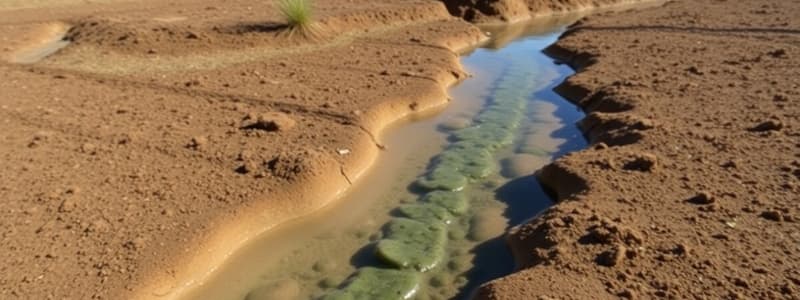Podcast
Questions and Answers
Which of the following factors can produce spontaneous potentials?
Which of the following factors can produce spontaneous potentials?
- Geothermal Gradient (correct)
- Air quality
- Volcanic eruptions
- Photosynthesis
Spontaneous potentials are exclusively produced by geothermal activity.
Spontaneous potentials are exclusively produced by geothermal activity.
False (B)
Name one application of mapping related to groundwater.
Name one application of mapping related to groundwater.
Geological mapping
Spontaneous potentials may arise from _______ differences.
Spontaneous potentials may arise from _______ differences.
Match the following causes of spontaneous potentials with their descriptions:
Match the following causes of spontaneous potentials with their descriptions:
What is located above the reduction zone in the provided content?
What is located above the reduction zone in the provided content?
The mechanism of self-potential is associated with polarizing electrodes.
The mechanism of self-potential is associated with polarizing electrodes.
Name the two zones mentioned in the content.
Name the two zones mentioned in the content.
The _____ electrodes are mentioned in relation to the mechanism of self-potential.
The _____ electrodes are mentioned in relation to the mechanism of self-potential.
Match the terms with their corresponding descriptions:
Match the terms with their corresponding descriptions:
What is a possible risk associated with managing survey profiles and Cu SO4?
What is a possible risk associated with managing survey profiles and Cu SO4?
What characteristic should the wire used in SP surveys have?
What characteristic should the wire used in SP surveys have?
Electrodes must be leaped over one another when managing survey profiles.
Electrodes must be leaped over one another when managing survey profiles.
The resolution of the millivolt meter can only be 1.0 mV.
The resolution of the millivolt meter can only be 1.0 mV.
What substance is mentioned that requires careful management during the survey?
What substance is mentioned that requires careful management during the survey?
What should be maintained similar between the two pots to avoid creating an unwanted potential?
What should be maintained similar between the two pots to avoid creating an unwanted potential?
Care must be taken to keep track of the __________ when managing survey profiles.
Care must be taken to keep track of the __________ when managing survey profiles.
Match the following terms related to survey profiles with their descriptions:
Match the following terms related to survey profiles with their descriptions:
One electrode is kept __________ at a base station on unmineralised ground.
One electrode is kept __________ at a base station on unmineralised ground.
Match the following characteristics related to the SP survey:
Match the following characteristics related to the SP survey:
What is the primary method of interpretation used in surveys?
What is the primary method of interpretation used in surveys?
Anomalies in the survey profile are typically found at higher elevations.
Anomalies in the survey profile are typically found at higher elevations.
What does the depth in surveys refer to?
What does the depth in surveys refer to?
In survey profiles, the anomaly minimum is observed over the ______ body.
In survey profiles, the anomaly minimum is observed over the ______ body.
Match the following terms with their definitions:
Match the following terms with their definitions:
What does the shape of the anomaly indicate?
What does the shape of the anomaly indicate?
A steep slope and positive tail of the anomaly can be found on the up-dip side.
A steep slope and positive tail of the anomaly can be found on the up-dip side.
What type of anomaly is observed over water flowing out of a fracture zone?
What type of anomaly is observed over water flowing out of a fracture zone?
The steep slope and positive tail of the anomaly are associated with the ______ side.
The steep slope and positive tail of the anomaly are associated with the ______ side.
Match the following terms with their descriptions:
Match the following terms with their descriptions:
Flashcards
Spontaneous Potentials
Spontaneous Potentials
Electrical signals generated naturally, often related to geothermal activity, mineral differences, or biological processes.
Geothermal Gradient
Geothermal Gradient
Rate of change in temperature with depth beneath the Earth's surface.
Mineralization Differences
Mineralization Differences
Variations in the concentration or type of minerals in the earth.
Electrochemical Action
Electrochemical Action
Signup and view all the flashcards
SP Profile
SP Profile
Signup and view all the flashcards
Oxidation Zone
Oxidation Zone
Signup and view all the flashcards
Water Table
Water Table
Signup and view all the flashcards
Reduction Zone
Reduction Zone
Signup and view all the flashcards
Self-Potential (S-P)
Self-Potential (S-P)
Signup and view all the flashcards
Nonpolarizing Electrodes
Nonpolarizing Electrodes
Signup and view all the flashcards
Cu SO4
Cu SO4
Signup and view all the flashcards
Electrode Potential
Electrode Potential
Signup and view all the flashcards
Two Electrodes
Two Electrodes
Signup and view all the flashcards
Fixed Separation
Fixed Separation
Signup and view all the flashcards
Leap-Frogging Electrodes
Leap-Frogging Electrodes
Signup and view all the flashcards
Survey wire material properties
Survey wire material properties
Signup and view all the flashcards
Millivolt meter resolution
Millivolt meter resolution
Signup and view all the flashcards
Pot temperature control
Pot temperature control
Signup and view all the flashcards
Electrode placement (fixed)
Electrode placement (fixed)
Signup and view all the flashcards
Electrode placement (moving)
Electrode placement (moving)
Signup and view all the flashcards
Anomaly Symmetry
Anomaly Symmetry
Signup and view all the flashcards
Down-Dip Anomaly
Down-Dip Anomaly
Signup and view all the flashcards
Positive Tail of Anomaly
Positive Tail of Anomaly
Signup and view all the flashcards
Self-Potential Anomaly
Self-Potential Anomaly
Signup and view all the flashcards
Fracture Zone
Fracture Zone
Signup and view all the flashcards
Survey Profile
Survey Profile
Signup and view all the flashcards
Anomaly Minimum
Anomaly Minimum
Signup and view all the flashcards
Anomalous Body
Anomalous Body
Signup and view all the flashcards
Displaced Downhill
Displaced Downhill
Signup and view all the flashcards
Depth (Half-Amplitude)
Depth (Half-Amplitude)
Signup and view all the flashcards
Study Notes
Electric Methods
- Self-potential (SP) method
- Resistivity methods
- Induced polarization
Self-Potential (SP) Method
- Based on surface measurement of natural potentials caused by electrochemical reactions in the subsurface.
- Doesn't require injecting electric currents into the ground.
- Useful in groundwater and geothermal investigations, engineering applications (e.g., mapping seepage flow), and geological mapping (e.g., delineating shear zones and dams near water tables).
- Simpler to operate in the field compared to other methods
- Can be used to locate massive metallic deposits and disseminated ores.
SP Method: Mechanism
- Spontaneous potentials are generated by:
- Mineralization differences
- Electrochemical action
- Geothermal activity
- Bioelectric generation of vegetation
SP Method: Equipment
- Nonpolarizing electrodes: Crucial for accurate measurements without introducing artificial potentials.
- Survey wire: Needs to be strong, durable, and have low resistance for reliable data transmission.
- Millivolt meter: Must have high resolution (e.g., 0.1 or 1.0 mV) to detect subtle voltage variations.
SP Method: Survey Procedure
- Remote Electrode: One electrode is kept fixed at a base station on unmineralised ground.
- SP Data Recording: The other electrode is moved along the survey profile.
- Dipole System: Two electrodes with fixed spacing are leap-frogged, one over the other, for mapping.
- Temperature Control: Maintaining similar temperatures in the electrodes prevents creation of unwanted potentials (e.g., 0.5 mV increase/degree Celcius for Cu/CuSO4).
- Polarity Tracking: Careful documentation and tracking of the potential polarity is necessary.
SP Method: Interpretation
- Primarily qualitative, focusing on identifying patterns and anomalies related to subsurface features rather than precise quantitative measurements.
- Depth: Determined by the width of the half-amplitude of the anomaly .
- Symmetry: The shape (symmetry or asymmetry) of the anomaly reveals information about the orientation (attitude) of the subsurface body (underground).
- Tail of the anomaly: The slope of the anomaly's positive tail generally aligns with the down dip side of the body. The steep slope and length of this tail are also used for interpretation.
Studying That Suits You
Use AI to generate personalized quizzes and flashcards to suit your learning preferences.




